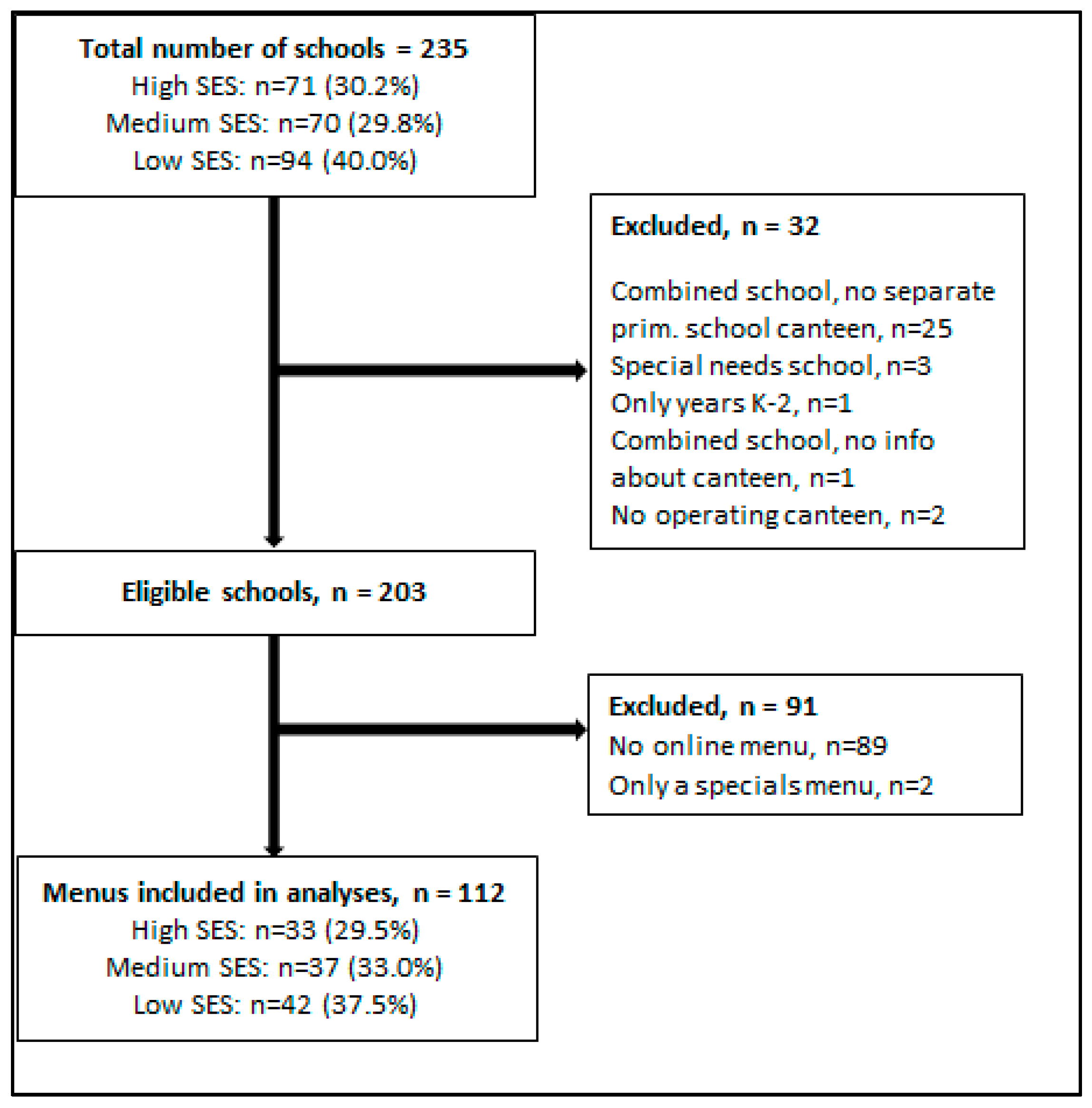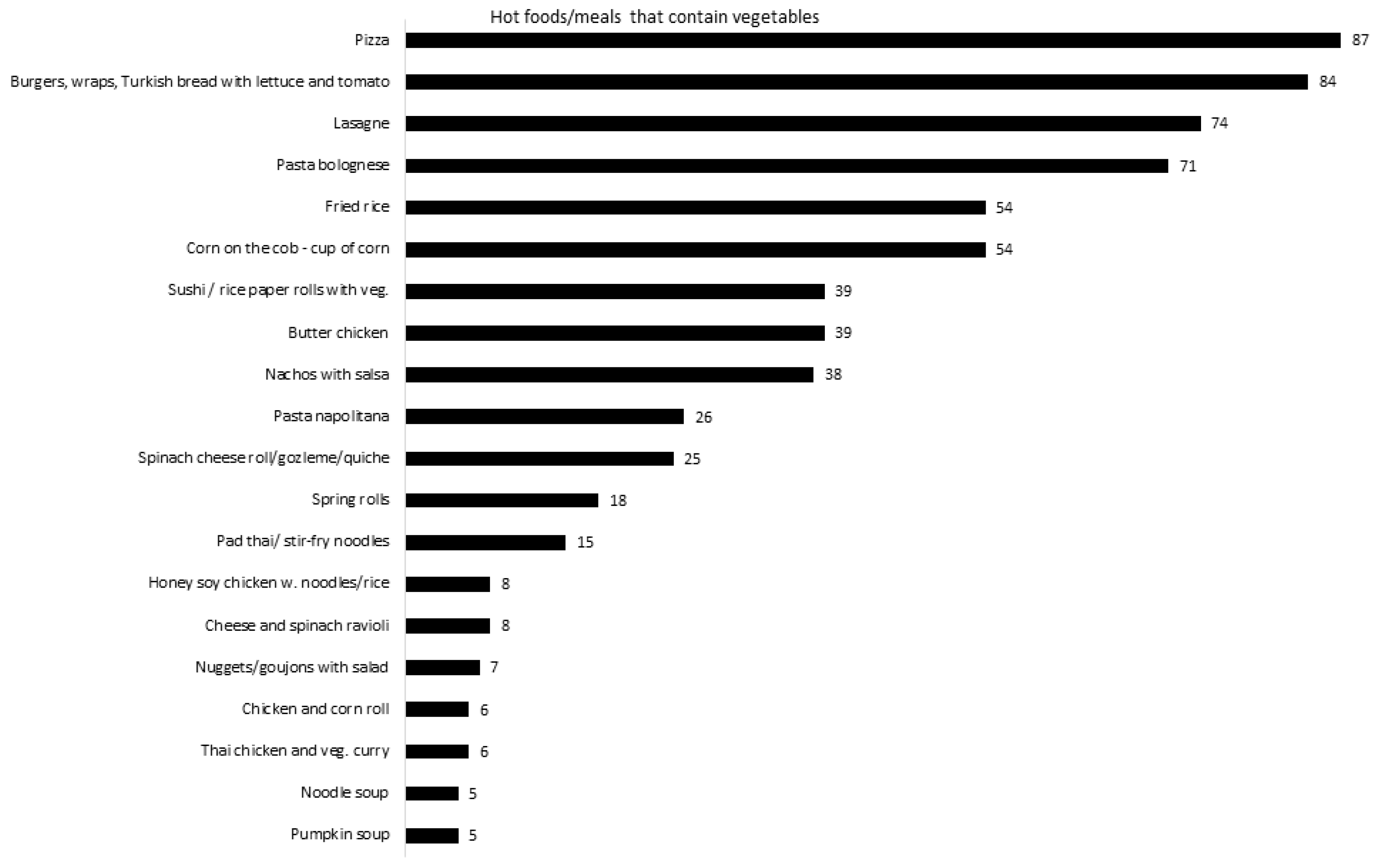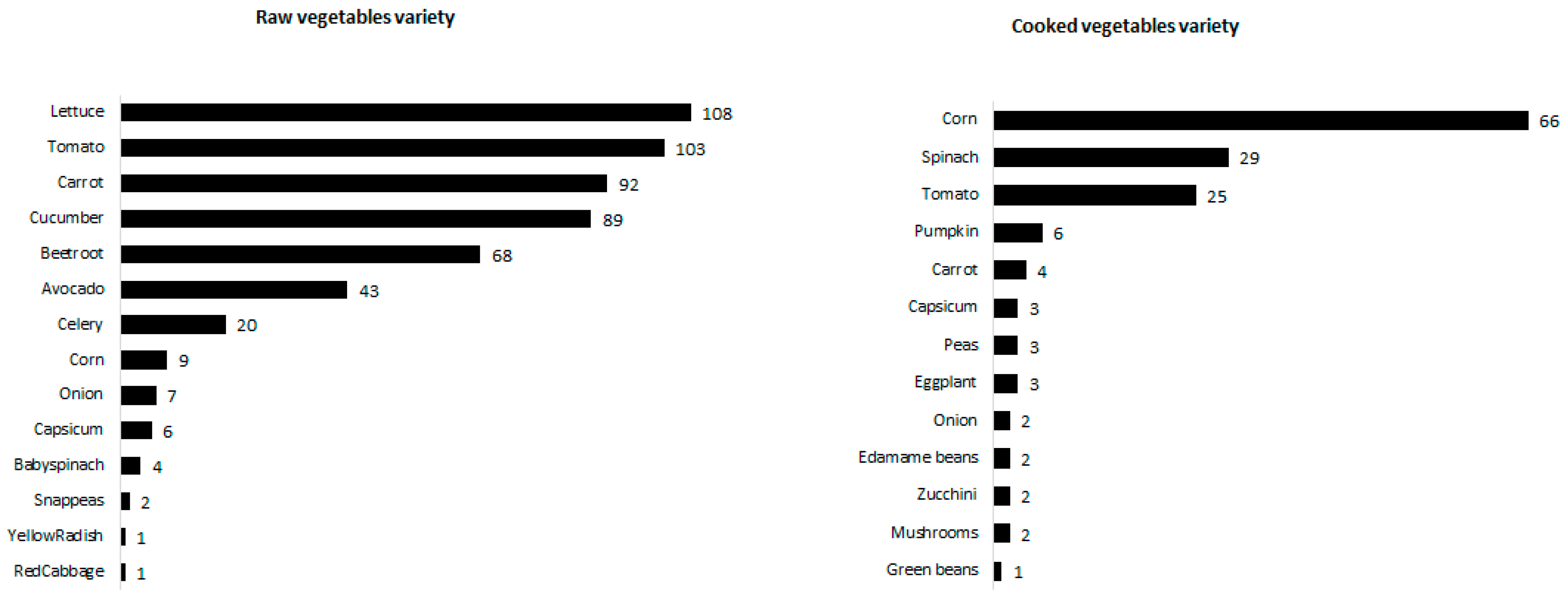Menu Audit of Vegetable-Containing Food Offering in Primary School Canteens in Sydney, Australia: A Preliminary Study
Abstract
:1. Introduction
2. Materials and Methods
3. Results
4. Discussion
5. Conclusions
Author Contributions
Funding
Data Availability Statement
Conflicts of Interest
References
- Mihrshahi, S.; Myton, R.; Partridge, S.R.; Esdaile, E.; Hardy, L.L.; Gale, J. Sustained low consumption of fruit and vegetables in Australian children: Findings from the Australian National Health Surveys. Health Promot. J. Aust. 2019, 30, 83–87. [Google Scholar] [CrossRef] [Green Version]
- Kim, S.A.; Moore, L.V.; Galuska, D.; Wright, A.P.; Harris, D.; Grummer-Strawn, L.M.; Merlo, C.L.; Nihiser, A.J.; Rhodes, D.G. Vital signs: Fruit and vegetable intake among children—United States, 2003–2010. MMWR Morb. Mortal. Wkly. Rep. 2014, 63, 671. [Google Scholar]
- Yngve, A.; Wolf, A.; Poortvliet, E.; Elmadfa, I.; Brug, J.; Ehrenblad, B.; Franchini, B.; Haraldsdóttir, J.; Krølner, R.; Maes, L.; et al. Fruit and vegetable intake in a sample of 11-year-old children in 9 European countries: The Pro Children Cross-Sectional survey. Ann. Nutr. Metab. 2005, 49, 236–245. [Google Scholar] [CrossRef] [PubMed] [Green Version]
- Australian Government Department of Health. Recommended Number of Serves for Children, Adolescents and Toddlers. 2015. Available online: https://www.eatforhealth.gov.au/food-essentials/how-much-do-we-need-each-day/recommended-number-serves-children-adolescents-and (accessed on 31 July 2020).
- Australian Bureau of Statistics. National Health Survey: First Results (2017–2018). 2018. Available online: https://www.abs.gov.au/statistics/health/health-conditions-and-risks/dietary-behaviour/latest-release#children-s-dietary-behaviours (accessed on 31 October 2021).
- Ambrosini, G. Childhood dietary patterns and later obesity: A review of the evidence. Proc. Nutr. Soc. 2014, 73, 137–146. [Google Scholar] [CrossRef]
- He, F.J.; Nowson, C.A.; Lucas, M.; MacGregor, G.A. Increased consumption of fruit and vegetables is related to a reduced risk of coronary heart disease: Meta-analysis of cohort studies. J. Hum. Hypertens. 2007, 21, 717–728. [Google Scholar] [CrossRef] [PubMed] [Green Version]
- Zhan, J.; Liu, Y.-J.; Cai, L.-B.; Xu, F.-R.; Xie, T.; He, Q.-Q. Fruit and vegetable consumption and risk of cardiovascular disease: A meta-analysis of prospective cohort studies. Crit. Rev. Food Sci. Nutr. 2017, 57, 1650–1663. [Google Scholar] [CrossRef] [PubMed]
- Mikkilä, V.; Räsänen, L.; Raitakari, O.T.; Pietinen, P.; Viikari, J. Consistent dietary patterns identified from childhood to adulthood: The cardiovascular risk in Young Finns Study. Br. J. Nutr. 2005, 93, 923–931. [Google Scholar] [CrossRef] [PubMed]
- Wyse, R.; Campbell, E.; Nathan, N.; Wolfenden, L. Associations between characteristics of the home food environment and fruit and vegetable intake in preschool children: A cross-sectional study. BMC Public Health 2011, 11, 938. [Google Scholar] [CrossRef] [PubMed] [Green Version]
- Lucas, P.J.; Patterson, E.; Sacks, G.; Billich, N.; Evans, C.E.L. Preschool and school meal policies: An overview of what we know about regulation, implementation, and impact on diet in the UK, Sweden, and Australia. Nutrients 2017, 9, 736. [Google Scholar] [CrossRef]
- Bell, A.C.; Swinburn, B.A. What are the key food groups to target for preventing obesity and improving nutrition in schools? Eur. J. Clin. Nutr. 2004, 58, 258–263. [Google Scholar] [CrossRef] [Green Version]
- Johnston, C.A.; Moreno, J.P.; El-Mubasher, A.; Woehler, D. School lunches and lunches brought from home: A comparative analysis. Child. Obes. 2012, 8, 364–368. [Google Scholar] [CrossRef]
- Micha, R.; Karageorgou, D.; Bakogianni, I.; Trichia, E.; Whitsel, L.P.; Story, M.; Peñalvo, J.L.; Mozaffarian, D. Effectiveness of school food environment policies on children’s dietary behaviors: A systematic review and meta-analysis. PLoS ONE 2018, 13, e0194555. [Google Scholar] [CrossRef] [PubMed]
- Food and Nutrition Service. Nutrition Standards in the National School Lunch and School Breakfast Programs: Final Rule. Fed. Regist. 2012, 77, 4087–4167. [Google Scholar]
- NSW Ministry of Health. The NSW Healthy School Canteen Strategy—Food and Drink Benchmark; NSW Ministry of Health: St Leonards, NSW, Australia, 2017.
- Hills, A.; Nathan, N.; Robinson, K.; Fox, D.; Wolfenden, L. Improvement in primary school adherence to the NSW Healthy School Canteen Strategy in 2007 and 2010. Health Promot. J. Aust. 2015, 26, 89–92. [Google Scholar] [CrossRef] [PubMed]
- Myers, G.; Sauzier, M.; Ferguson, A.; Pettigrew, S. Objective assessment of compliance with a state-wide school food-service policy via menu audits. Public Health Nutr. 2019, 22, 1696–1703. [Google Scholar] [CrossRef]
- Nathan, N.; Yoong, S.L.; Sutherland, R.; Reilly, K.; Delaney, T.; Janssen, L.; Robertson, K.; Reynolds, R.; Chai, L.K.; Lecathelinais, C.; et al. Effectiveness of a multicomponent intervention to enhance implementation of a healthy canteen policy in Australian primary schools: A randomised controlled trial. Int. J. Behav. Nutr. Phys. Act. 2016, 13, 106. [Google Scholar] [CrossRef] [PubMed] [Green Version]
- Reilly, K.; Nathan, N.; Wolfenden, L.; Wiggers, J.H.; Sutherland, R.; Wyse, R.; Yoong, S.L. Validity of four measures in assessing school canteen menu compliance with state-based healthy canteen policy. Health Promot. J. Aust. 2016, 27, 215–221. [Google Scholar] [CrossRef] [PubMed]
- Woods, J.; Bressan, A.; Langelaan, C.; Mallon, A.; Palermo, C. Australian school canteens: Menu guideline adherence or avoidance? Health Promot. J. Aust. 2014, 25, 110–115. [Google Scholar] [CrossRef]
- Yoong, S.L.; Nathan, N.K.; Wyse, R.J.; Preece, S.J.; Williams, C.M.; Sutherland, R.L.; Wiggers, J.H.; Delaney, T.M.; Wolfenden, L. Assessment of the school nutrition environment: A study in Australian primary school canteens. Am. J. Prev. Med. 2015, 49, 215–222. [Google Scholar] [CrossRef]
- Nicklaus, S.; Boggio, V.; Issanchou, S. Food choices at lunch during the third year of life: High selection of animal and starchy foods but avoidance of vegetables. Acta Paediatr. 2007, 94, 943–951. [Google Scholar] [CrossRef]
- Bell, L.K.; Gardner, C.; Tian, E.J.; Cochet-Broch, M.O.; Poelman, A.A.M.; Cox, D.N.; Nicklaus, S.; Matvienko-Sikar, K.; Daniels, L.A.; Kumar, S.; et al. Supporting strategies for enhancing vegetable liking in the early years of life: An umbrella review of systematic reviews. Am. J. Clin. Nutr. 2021, 113, 1282–1300. [Google Scholar] [CrossRef] [PubMed]
- Darmon, N.; Drewnowski, A. Does social class predict diet quality? Am. J. Clin. Nutr. 2008, 87, 1107–1117. [Google Scholar] [CrossRef] [Green Version]
- Australian Bureau of Statistics. SEIFA 2011. 2011. Available online: https://www.abs.gov.au/ausstats/abs@.nsf/Lookup/by%20Subject/2033.0.55.001~2011~Main%20Features~Main%20Page~1 (accessed on 30 November 2018).
- World Health Organization. Global Strategy on Diet. Physical Activity and Health. Available online: https://www.who.int/dietphysicalactivity/fruit/en/ (accessed on 31 July 2020).
- World Health Organization. Healthy Diet. 2020. Available online: https://www.who.int/en/news-room/fact-sheets/detail/healthy-diet (accessed on 31 July 2020).
- Cancer Council Western Australia. Crunch on Vegetables. 2020. Available online: https://www.crunchandsip.com.au/parents/healthy-tips/crunch-on-vegetables (accessed on 31 October 2020).
- NSW Government Department of Health. Crunch&Sip®. 2019. Available online: https://www.health.nsw.gov.au/heal/primaryschools/Pages/crunch-and-sip.aspx (accessed on 31 July 2020).
- Wolfenden, L.; Nathan, N.; Janssen, L.M.; Wiggers, J.; Reilly, K.; Delaney, T.; Williams, C.M.; Bell, C.; Wyse, R.; Sutherland, R.; et al. Multi-strategic intervention to enhance implementation of healthy canteen policy: A randomised controlled trial. Implement. Sci. 2017, 12, 6. [Google Scholar] [CrossRef] [PubMed] [Green Version]
- Dubuisson, C.; Lioret, S.; Calamassi-Tran, G.; Volatier, J.-L.; Lafay, L. School meals in French secondary state schools with regard to the national recommendations. Br. J. Nutr. 2008, 102, 293–301. [Google Scholar] [CrossRef] [PubMed] [Green Version]
- Hendrie, G.A.; Lease, H.J.; Bowen, J.; Baird, D.L.; Cox, D.N. Strategies to increase children’s vegetable intake in home and community settings: A systematic review of literature. Matern. Child Nutr. 2017, 13, e12276. [Google Scholar] [CrossRef] [Green Version]
- Birch, L.L. Development of food preferences. Annu. Rev. Nutr. 1999, 19, 41–62. [Google Scholar] [CrossRef] [Green Version]
- Poelman, A.; Delahunty, C.M.; de Graaf, C. Vegetables and other core food groups: A comparison of key flavour and texture properties. Food Qual. Prefer. 2017, 56, 1–7. [Google Scholar] [CrossRef]



| Total Number of Items (n) | Number of Items with Vegetables (n) | |||||
|---|---|---|---|---|---|---|
| Category | Number of Menus Listing the Category (n) 1 | Mean | SD | Mean | SD | Proportion of Items with Vegetables (%) |
| Overall | 112 | 80.4 | 34.0 | 25.7 | 15.8 | 30.4% |
| Beverages | 112 | 10.8 | 4.5 | 0 | 0 | 0.0% |
| Hot meals/foods | 112 | 22.1 | 9.7 | 10.6 | 5.8 | 46.2% |
| Sandwiches | 110 | 16.1 | 7.9 | 7.2 | 5.6 | 39.7% |
| Salads | 93 | 5.8 | 3.8 | 5.8 | 3.8 | 100.0% |
| Snacks | 111 | 23.7 | 12.3 | 2.4 | 3.9 | 7.9% |
| Meal deals | 41 | 6.5 | 4.9 | 3.2 | 2.5 | 50.5% |
| Small | Medium | Large | Government | Non-Government | ||||||
|---|---|---|---|---|---|---|---|---|---|---|
| Mean | SD | Mean | SD | Mean | SD | Mean | SD | Mean | SD | |
| Overall | 27.8 b | 8.5 | 32.0 ab | 8.5 | 33.3 a | 7.8 | 30 | 8.8 | 31.9 | 7.8 |
| Hot meals/foods | 43.1 b | 14.4 | 44.6 ab | 15.1 | 52.0 a | 11.3 | 46.3 | 14.4 | 45.9 | 13.5 |
| Sandwiches | 35.3 | 19.3 | 45.7 | 14.5 | 42.6 | 17.2 | 39.4 | 18.4 | 41.1 | 17.4 |
| Salads | 100 | 0 | 100 | 0 | 100 | 0 | 100 | 0 | 100 | 0 |
| Snacks | 6.2 b | 8.5 | 7.0 ab | 9.4 | 10.9 a | 8 | 8.8 | 9.1 | 3.7 * | 5.2 |
| Meal deals | 55.9 | 27.4 | 43.1 | 34.2 | 49.7 | 19.4 | 53.9 | 26.4 | 30.5 * | 23.9 |
Publisher’s Note: MDPI stays neutral with regard to jurisdictional claims in published maps and institutional affiliations. |
© 2021 by the authors. Licensee MDPI, Basel, Switzerland. This article is an open access article distributed under the terms and conditions of the Creative Commons Attribution (CC BY) license (https://creativecommons.org/licenses/by/4.0/).
Share and Cite
Beelen, J.; Heffernan, J.E.; Cochet-Broch, M.; Djakovic, S.; Chung, D.; Golley, R.K.; Poelman, A.A.M. Menu Audit of Vegetable-Containing Food Offering in Primary School Canteens in Sydney, Australia: A Preliminary Study. Int. J. Environ. Res. Public Health 2021, 18, 11789. https://doi.org/10.3390/ijerph182211789
Beelen J, Heffernan JE, Cochet-Broch M, Djakovic S, Chung D, Golley RK, Poelman AAM. Menu Audit of Vegetable-Containing Food Offering in Primary School Canteens in Sydney, Australia: A Preliminary Study. International Journal of Environmental Research and Public Health. 2021; 18(22):11789. https://doi.org/10.3390/ijerph182211789
Chicago/Turabian StyleBeelen, Janne, Jessica E. Heffernan, Maeva Cochet-Broch, Shadia Djakovic, David Chung, Rebecca K. Golley, and Astrid A. M. Poelman. 2021. "Menu Audit of Vegetable-Containing Food Offering in Primary School Canteens in Sydney, Australia: A Preliminary Study" International Journal of Environmental Research and Public Health 18, no. 22: 11789. https://doi.org/10.3390/ijerph182211789
APA StyleBeelen, J., Heffernan, J. E., Cochet-Broch, M., Djakovic, S., Chung, D., Golley, R. K., & Poelman, A. A. M. (2021). Menu Audit of Vegetable-Containing Food Offering in Primary School Canteens in Sydney, Australia: A Preliminary Study. International Journal of Environmental Research and Public Health, 18(22), 11789. https://doi.org/10.3390/ijerph182211789








